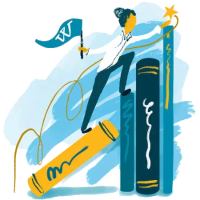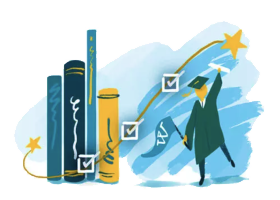Every journey starts with a single step. It's a cliché that you've seen on T-shirts and posters—and one that people trot out when talking about embarking on a degree program. We'd actually say that it needs a little modification: Every journey starts with the hardest step.
The Hardest Step: Starting
According to The New York Times, there are 37 million Americans with some college experience but no degree.* While there's a wide variety of reasons that people don’t return to college—financial limitations, time constraints, career paths—the biggest hurdle is the initial overwhelming prospect of starting again.
You may have envisioned a traditional college trajectory, living on campus and attending classroom lectures. Once you've started holding down a job or building a career or family, however, that idealized student life is unrealistic—and isn’t even the most common student story any more. In fact, "nontraditional" students are the new majority: people who are older, have more developed career paths and lives, and have very specific goals and aspirations. People like you.
And so a different kind of student journey begins: Finding a degree program that fits your lifestyle but still moves you in the direction of achieving your goals. For some, the convenient, flexible format of an online program from an accredited institution offers a path to the degree that will improve their lives. But even that route can mean a substantial investment of tuition and time.
Another approach to online learning is gaining popularity with future-focused students, and for good reason: it offers a way to control not just how and when you work toward your degree, but also how much you pay. These programs use a model known as competency-based learning, where you can apply your experience—both academic and on the job—to speed your progress toward your ultimate objective.
The Next Step: Covering the Right Distance
One advantage of competency-based learning is that rather than focusing on how much time you spend studying a subject, the goal is to measure how well you really know it. If you're studying a topic that you know well because of job experience, you're not stuck sitting in a classroom, listening to information that you've learned firsthand. Competency-based assessment puts all your knowledge and experience to the test so that you can show what you know, and move on to new topics to master.
At the same time, competency-based learning allows you the time you need to truly absorb and understand topics that might be more challenging for you. Rather than having your progress depend on a huge end-of-semester evaluation (determining whether or not you can move forward), competency-based learning offers multiple ongoing assessments—ways to rigorously check and double-check what you have learned.
This way, you can track on an ongoing basis what you understand and what areas require more study or research, and then focus your learning only on the areas that need attention. You can take assessments multiple times to identify where you need additional help—plus there’s support to move you forward: faculty, study aids, and learning activities, all geared toward taking you to the next level.
And when you do need expert assistance, competency-based learning programs provide faculty coaches, assessors, and subject matter experts to help you stay on track. Simply by the nature of the learn-assess-repeat process, faculty members can focus on teaching vs. testing—a win-win situation for everyone.
The Last Step to Finishing Your Degree: Setting the Right Pace
Someone fresh out of high school and just starting their college career may not be bringing much life experience to their education. In competency-based programs, students who are older and have a little more educational, work, and life experience have an edge. Applied knowledge finds a place in these programs, since the competencies include many facets that address real-life, work-applicable situations.
The curriculum for competency-based degree programs isn't determined solely by academics; industry and education experts are included to ensure that programs are designed to prepare students with the right skills for the workplace. Learning is directly applicable to day-to-day work lives. Combine that with the ability to move through a program at just the right speed—quickly for familiar topics, more thoroughly for new concepts—and students can progress toward their degree at their fastest possible rate.
A Competency-Based Program: Designed for Lifelong Learning
People who work in competency-based learning programs have a saying: “Time is flexible, but mastery is mandatory.” It’s shorthand for everything that is challenging and wonderful about this approach to learning.
It's a way to speed your journey to the education you want, without giving up the life you live. It’s the chance to be a student—but on your terms and schedule. It’s an opportunity to get that degree—but to be sure that it includes a meaningful education and tools for succeeding in the workforce. And most of all, it’s a way to reward the part of you that’s always curious and wanting to learn and do more, and to become the best version of yourself—in the shortest possible time.
Discover how you can advance your education while setting your own pace with Tempo Learning by Walden University.
*Kamenetz, Anya. (2013, October 29). Are You Competent? Prove It. The New York Times. Retrieved from www.nytimes.com/2013/11/03/education/edlife/degrees-based-on-what-you-can-do-not-how-long-you-went.html?pagewanted=all&module=Search&mabReward=relbias%3Ar&_r=1&;



